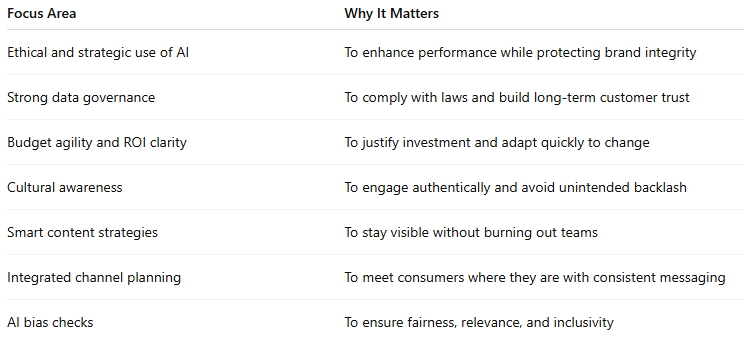Crack the Code: How to Tackle the Toughest Marketing Hurdles of 2025
Based on 20+ years of experience, here’s your inside guide to solving 2025’s most urgent marketing puzzles.
Here’s what I’ve seen emerging as the most pressing challenges facing marketers in 2025 and beyond, based on both my experience and what I’ve observed across industries.
1. The AI Revolution: Opportunity Meets Risk
Artificial intelligence has become the sharpest tool in the marketing toolkit. I use it regularly to generate ad copy, test variations, segment audiences, and streamline reporting. It saves hours and frees up creative energy.
But with that power comes real risk.
Some marketers are over-relying on AI, trusting outputs without fully understanding how the model reached its conclusions. Others are unintentionally deploying manipulative messaging by pushing personalization too far. Add in the ethical questions and skill gaps, and you’ve got a landscape that requires constant learning and responsibility (Deshpande, 2025; Time, 2025).
2. Privacy and Compliance Fatigue
Marketers today face a web of regulations around data privacy, and it keeps growing. Between GDPR, CCPA updates, and new global laws targeting AI-powered personalization, the days of carefree tracking are long gone (Microsoft Advertising, 2025; Wall Street Journal, 2025a).
In my work, we've had to invest in tools and training to ensure that we’re collecting and using data ethically and transparently. More importantly, we’ve realized that compliance is not just a box to check. It’s a commitment to earning and maintaining customer trust.
3. Budget Pressures and Economic Uncertainty
Marketing budgets are tightening in many industries. Economic conditions, inflation, and cautious consumer behavior have forced brands to become more selective with spending (Business Insider, 2025).
I’ve found that success in this environment comes from becoming a translator. Marketers need to translate their impact into metrics that the C-suite understands. That means scenario planning, real-time dashboards, and a clear narrative about ROI. It's not enough to say “this campaign worked.” You need to show how and why it mattered to revenue.
4. Cultural Polarization and Brand Messaging
We’re in an era where brands are retreating from bold social messaging. Not because they don’t believe in causes, but because the cultural backlash can be intense and unpredictable (Wired, 2025; Financial Times, 2025).
I’ve seen marketing teams grapple with where to stand, or whether to take a stand at all. In 2025, tone, context, and timing are everything. What might have been praised in 2020 could now result in lost customers and PR nightmares. Navigating this space takes courage, empathy, and real cultural fluency.
5. Content Overload and Attribution Confusion
The pressure to produce high volumes of content has never been higher. At the same time, figuring out what content actually drives conversions is more complicated than ever.
To avoid burnout and wasted effort, I’ve adopted a modular content approach. We build core messaging that can be reused across multiple platforms and tailored for different formats. On the analytics side, we’re leaning into predictive tools to connect the dots more accurately across channels.
6. Fragmented Channels, Integrated Strategies
Customers don’t think in channels. They move fluidly from podcast to TikTok to email to in-store experiences. The challenge for marketers is to create consistent and relevant messaging across all these touchpoints (O’Leary, 2025).
In my experience, success here requires strong collaboration between content, media, and technology teams. It also requires a shift in mindset. Campaigns are no longer linear. They are ecosystems.
7. Biased AI and the Need for Inclusive Marketing
Bias in AI is a real and growing concern. Several studies have shown that generative AI tools can unintentionally create content that excludes or stereotypes certain audiences (Yilmaz & Ashqar, 2025).
That hit home for me when I reviewed AI-generated ads that subtly shifted tone based on assumed audience demographics. Since then, we’ve built bias testing into our creative review process and started training our teams on inclusive design. It is an ongoing effort, but one that matters deeply.
What Marketers Need to Succeed in 2025
Looking ahead, here’s what I believe every marketer needs to focus on:
Marketing in 2025 is fast, fragmented, and high-stakes. But it is also full of opportunity. The tools are more powerful than ever. The data is richer. And the chance to create lasting impact is real.
From where I sit, the future belongs to the marketers who can think strategically, move ethically, and adapt fearlessly.
References
Business Insider. (2025, April). Marketers are trying to make themselves recession-proof. https://www.businessinsider.com/marketers-are-trying-to-make-themselves-recession-proof-2025-4
Deshpande, A. (2025, June). The future of marketing: 2025 and beyond. LinkedIn. https://www.linkedin.com/pulse/future-marketing-2025-beyond-key-trends-challenges-abhishek-deshpande
Financial Times. (2025, June). Why brands are retreating from woke messaging. https://www.ft.com/content/88949dbf-7be3-47ed-a6e2-48064bd3fa26
Microsoft Advertising. (2025, June). The future of AI personalization is inclusive. https://about.ads.microsoft.com/en/blog/post/june-2025/the-future-of-ai-personalization-is-inclusive
O’Leary, C. (2025, July). The five seismic shifts reshaping communications. Axios. https://www.axios.com/sponsored/5x-the-five-seismic-shifts-that-will-reshape-communications-and-marketing-over-the-next-five-years
Time. (2025, June). How hyper-personalized AI marketing can go too far. https://time.com/7296719/ai-personalization-harm-essay
Wall Street Journal. (2025a, June). Ad agencies brace for low growth amid AI disruption. https://www.wsj.com/articles/ad-agencies-low-growth-will-drag-on-as-they-adjust-to-era-of-ai-barclays-says-30725b38
Wired. (2025, June). The era of woke brand activism is over. https://www.wired.com/story/the-era-of-woke-brand-activism-is-over
Yilmaz, Y., & Ashqar, H. (2025, February). On the fairness of large language models in marketing applications. arXiv. https://arxiv.org/abs/2502.12838



